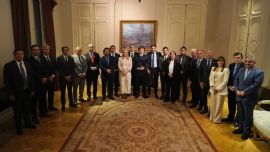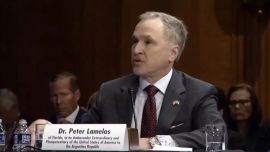It’s hard to find certainty only days before a transcendental election, particularly in an extremely complex political ecosystem like the one in Argentina. In that context, and in a world where polling techniques have been seriously called into question after a succession of substantial erroneous calls across multiple major elections, the public has become extremely skeptical. Not to add the intrinsic corruption of the polling market, where both candidates and pollsters leak dubious reports in order to try and sway the public opinion and the political field. Thus, it is difficult to find someone to stick their neck out like the team at Atlas Intel, led by their CEO Andrei Roman who this week suggested that Patricia Bullrich has a “nine out of 10” chance of becoming Argentina’s next president. His confidence, expressed during an interview on Modo Fontevecchia is tied to a recent report released by Atlas that indicates that her lead over contender Horacio Rodríguez Larreta in the Juntos por el Cambio primary is essentially irreversible. Furthermore, her hypothetical victory in the primaries would set her up for a general election that would lead to a runoff with Economy Minister Sergio Massa which would conclude with a victory for Bullrich.
The Atlas Intel report goes in line with the aggregated average of polls being released in Argentina which shows a technical draw between the opposition coalition and the Peronists, both hovering around the 35 percent mark, with ultra-liberal economist Javier Milei trending toward the 20 percent region, as Federico Tiberti’s data shows. Interestingly, Atlas’ figures indicate blank and spoiled ballots would only reach around two percent, while undecided voters total some three percent. High absenteeism, together with blank and spoiled ballots have been one of the defining factors in several provincial elections and are expected to play a major role in the upcoming primaries, which generally result in a lower turnout than the general elections, despite having a similar or even greater chance of defining the next president.
Going back to the PASO scenario, Atlas Intel’s figures suggest Massa would lead the individual vote with 26 percent, followed by Bullrich at 22.2 percent. Milei would come in third with 20.1 percent, relegating Rodríguez Larreta to the fourth spot with 11.6 percent of the vote. This scenario would confirm that Massa, together with social movement leader Juan Grabois (7.8 percent) would be able to hold the “floor” of around a third of the electorate to which Vice-President Cristina Fernández de Kirchner and the pan-Peronist coalition aspired. Furthermore, it would put Juntos por el Cambio, not so long ago expected to handily take the election, at parity with the governing coalition despite a disastrous macroeconomic situation including triple-digit inflation and stagnation. Regarding Milei, the discontent at coming in third when only two months ago he was the frontrunner shouldn’t mask the success of retaining a substantial portion of the electorate despite a series of scandals tied to selling candidacies across the country and the lack of a proper political structure at national level.
This result does appear surprising when taking a longer-term view, with the average of polls giving Juntos por el Cambio a substantial lead at least since late 2020, as the Alberto Fernández administration tore itself apart from the inside out. The civil war between the Fernándezes hit with all its might together with the after-effects of the global Covid-19 pandemic, the Russian invasion of Ukraine and a crippling drought, all of which exacerbated Argentina’s deep structural fragilities. Margins had compressed around April this year, when Milei’s rising star put his La Libertad Avanza party at parity with the hegemonic coalitions, taking votes from Juntos por el Cambio as Bullrich—egged on by Mauricio Macri—toughened her stance and went after her rival in the primaries. Since then, Milei’s star appears to have lost its lustre, while the undecided and blank votes have fallen steeply. According to an average of polls, the hegemonic coalitions are now in a neck-to-neck race which ultimately should come out in Juntos’ favour.
In what is probably the most interesting confrontation in the PASO primaries, Bullrich has emerged as a much more competitive candidate than Rodríguez Larreta, if the polls are correct. While the Mayor has been preparing for this moment his entire life, the former Security minister during the Macri administration teamed up with the former president and decided to push her ideological frontier out closer to Milei’s, trying to capture the disillusioned, angered and anti-system vote with a deep hatred for Kirchnerism. Rodríguez Larreta’s message of centrist moderation and uncharismatic technocrat personality probably played in her favour as well. If Bullrich were to take the primary, Atlas’ data suggest she would drag along the majority of Rodríguez Larreta’s votes (60.3 percent) while only losing a few to Milei (six percent). In the opposite scenario, the Mayor would retain a substantial portion of Bullrich’s voters (53.8 percent), but would hemorrhage 21 percent of the electorate toward Milei, enough to push him ahead and into the runoff, if Atlas’ data is correct. This is probably the most controversial part of the report. The number of projected blank and spoiled ballots, and undecided voters naturally grows substantially in the projected general election scenario, but the trend is clearly established.
The future is by definition unpredictable, and even close to some of the candidates there is great skepticism regarding what the opinion polls are indicating. Taking the Atlas Intel figures, and the aggregate averages, the general trend suggests the electorate is deeply fragmented, both between the increasingly obsolete left and right categories, and in terms of moderates and hardliners. The current political topography is going through tectonic shifts marking the end of a hegemonic bi-coalitionsim given the emergence of Milei and the right-wingers, along with the weakening of the Kirchnerites and the Macristas. If this pans out, the future legislative makeup would also result in a fragmented Congress which could potentially more easily amalgamate majorities, as centrist Peronists could play ball with the current constituents of Juntos por el Cambio and Milei’s ultra-liberals to pass certain structural reforms that every major candidate seems to suggest are necessary to liberate the economic potential of the country. Or it could be an illusion, with political infighting among even more players leading to continued gridlock.


















Comments